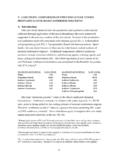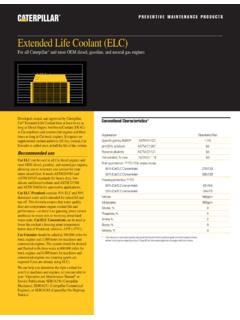Transcription of Extended Life Coolant - FAQ - RVcruzer.com
1 1 CAT Extended life COOLANTThe information contained herein includes recommendations regarding the maintenanceand testing of Coolant for trucks and earthmoving equipment using Cat Extended LifeCoolant (ELC). Further information is available in your Caterpillar Operation andMaintenance Manual . ELC utilizes patented carboxylate inhibitors that allow the coolantto go at least 600,000 miles, 6,000 hours or 6 years before a Coolant change. No SCA s areneeded. A single addition of Cat Extender is all that is required at 300,000 miles, 3,000hours or three years. It eliminates the need to use supplemental Coolant additives (SCA s).
2 The carboxylate inhibitors in ELC deplete very slowly. Furthermore, the carboxylatesprovide protection of wet sleeve cylinder liners, which eliminates the need for routinetesting of Coolant for nitrite and/or molybdate levels. When the cooling system ismaintained properly and ELC (or equivalent) is used for top up, there is no need toconduct routine testing for inhibitor levels. Therefore, when it comes to cooling systemmaintenance and testing, we suggest a focus on three areas for best maintenance practices: Freeze Point Testing Proper Top Up Cat S O S programSummary1. Test the Coolant for freeze point protection twice per Top up with Cat ELC premixed 50 Submit Level 1 SOS Coolant sample for analysis every 500 hours or if there isconcern over Coolant quality, contamination, or possible mechanical Use of nitrite and/or molybdate test strips is not necessary when using ELC (orequivalent) for top up.
3 If these test strips are used, no addition of supplementalcoolant additives (SCA s) should ever be made based on Point TestingCooling systems should be checked twice a year or at regular maintenance intervals toassure proper water glycol concentration ( freeze point). A 50/50 mixture isrecommended and provides freeze protection down to minus 34 F as well as optimumcorrosion protection. For vehicles operating in extremely cold climates, a concentration of60 percent ethylene glycol will provide freeze protection down to minus 59 greater than 60 percent are not recommended.
4 Use of Cat Extended LifeCoolant Pre-Diluted 50/50 (ELC 50/50) for top up significantly reduces concern ofglycol/water concentrations getting out of Top UpThe carboxylate inhibitors in ELC deplete very slowly and do not require routine testing toassure Coolant quality. Furthermore, the carboxylates provide protection of wet sleevecylinder liners, which eliminates the need for routine testing of Coolant for nitrite and/ormolybdate levels. When the cooling system is maintained properly and ELC (orequivalent) is used for top up, there is no need to conduct routine testing for TestingWhen freeze point testing of the Coolant is conducted, a visual inspection of the coolantshould be made.
5 The Coolant should be red/orange in color and should appear to be free ofdirt, debris, rust, and other contaminants. If the Coolant appears to be significantlycontaminated then a Level 2 SOS sample should be submitted for are two primary reasons the Coolant might not appear to be in good condition:1. Mechanical Contamination/dilution with conventional coolants of different color andchemical problems might include an oil cooler leak or exhaust blow by into the these situations occur, a SOS Level 2, laboratory analysis is useful to help identifyand/or confirm the with conventional coolants or over dilution with water can easily occurfrom improper top up procedures.
6 While laboratory testing has shown that ELC iscompatible with conventional coolants, top up with conventional coolants will result indilution of Extended life benefits. Cat literature states:Should top up occur with conventional Coolant (s) exceeding 10 percent of the totalcooling system capacity, either, drain and refill with ELC, or maintain as aconventional Coolant system using SCA s at recommended of the advantages of ELC is that routine testing for nitrite and other inhibitor levels isnot required unless there is a reason to believe the system has been significantlycontaminated with other coolants or foreign material.
7 For those that feel the need toconduct routine testing of the Coolant (other than freeze point) we suggest the following:1. ELC Field Test Kit - This kit is to be used when there is concern overpossible contamination of ELC with standard heavy-duty Coolant . This test kitwill provide pass/fail results on the carboxylate levels in the Coolant todetermine if the additive is in an acceptable range for continued use. The ELCF ield Test Kit can be obtained by ordering part number 172-8851 from yourCaterpillar SOS Level 1 Analysis This program provides a quick look into the conditionof your cooling system.
8 Level 1 analysis checks the freeze protection, nitritelevel, pH, conductivity, water hardness, and visual and odor analysis. Resultsare reported and appropriate recommendations are SOS Level 2 Analysis - Similar to the SOS Level 1 analysis, Level 2 canprovide additional information on the condition of the Coolant and coolingsystem of your engine and track history. It is recommend that SOS Level 2analysis be conducted annually as a check on the condition of the cooling3system, or if there is concern that the Coolant has been contaminated withstandard heavy duty Coolant or SCA TO COMMON QUESTIONS CONCERNING ELCNext 3 questions were moved from later in the : Why are trucks and equipment being filled with Extended life Coolant ?
9 Answer: As engine and truck builders extend service intervals, factory fill products mustbe able to reach the Extended service goals. Cat equipment is factory filled with ELCbecause we believe it is the best overall technology providing longer maintenance freeoperation and reducing overall maintenance costs. Some truck manufacturers are fillingnew trucks with Extended life Coolant to offer their customers what they feel is the highestcoolant performance and lowest maintenance expense available. For customers that chooseto use Extended life Coolant for top up, they can receive these benefits by the truck beingfactory filled.
10 For customers that desire not to change from current practices, they cancontinue use of conventional Coolant and SCA : I ve never heard of Extended life Coolant . Who else is using it and why?Answer: For many, Extended life Coolant offers lowest cost of ownership through longercoolant life , longer Coolant change intervals, the elimination of SCA s and routine inhibitortesting. Proper maintenance and top up procedures are necessary to realize these benefitsand every fleet or owner/operator should make their own assessment to assure thetechnology they use provides for lowest overall cost. Similar technology is used byGeneral Motors in their passenger cars and trucks.







